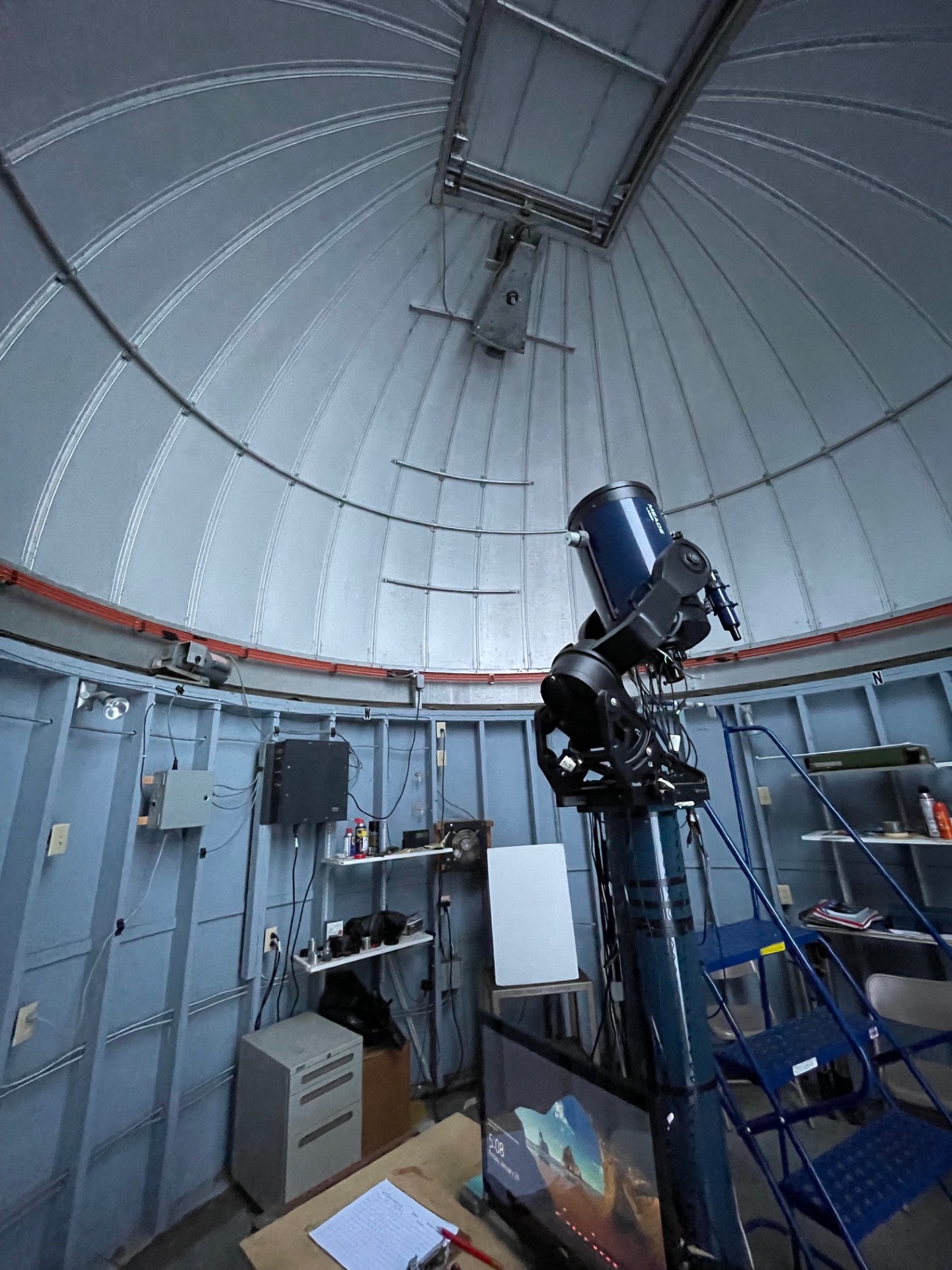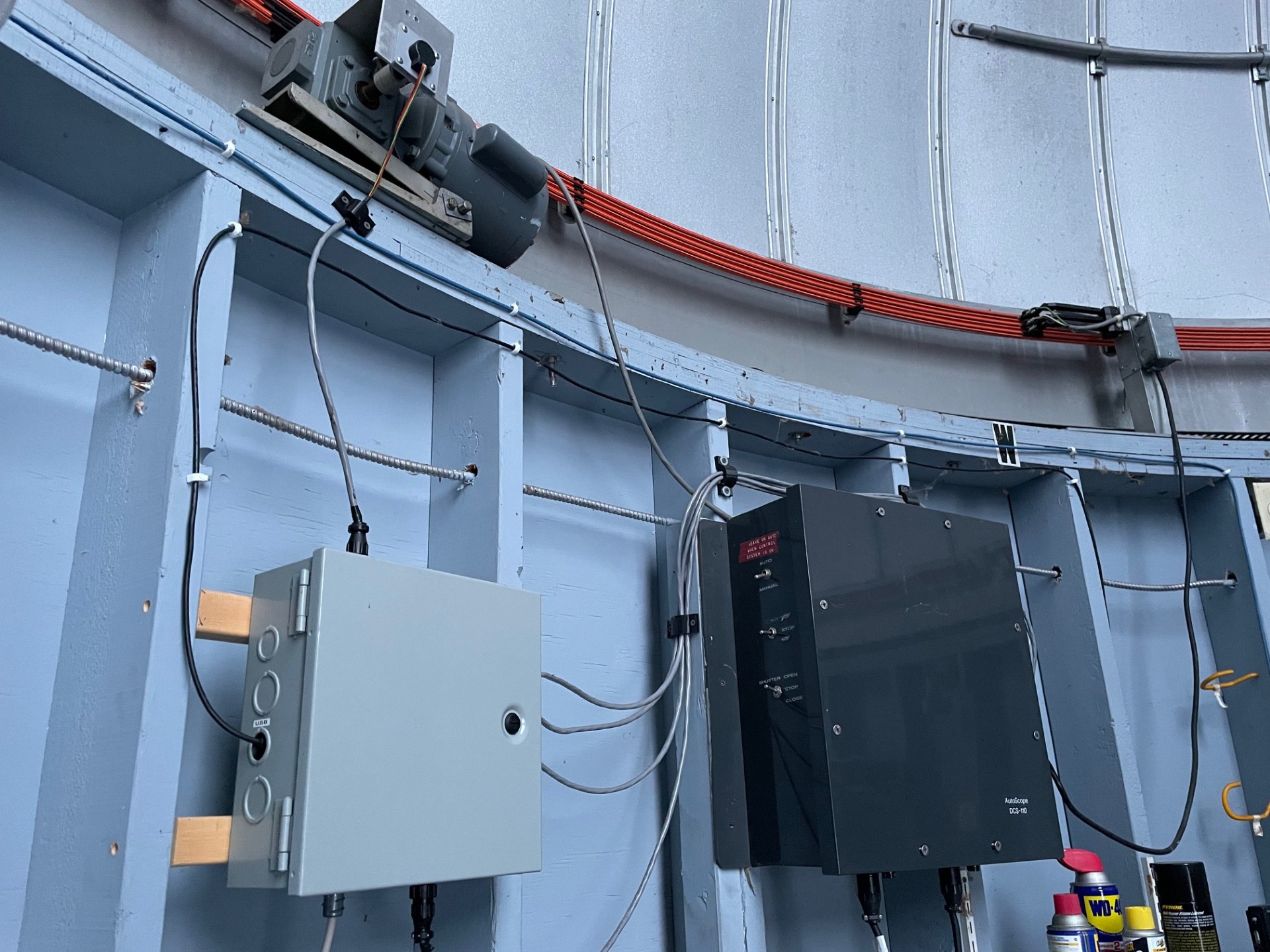
The RIT Observatory was moved to its current location at 645 John Street, Henrietta, at the southeastern corner of the RIT campus, back in 1999. Since that time, some of the facilities have started to age, and we've also discovered how certain aspects of our equipment are limiting our ability to operate efficiently. Finally, in the last few years, sophisticated automatic telescopes and detectors have become much more affordable and easy to use, opening new possibilities for our students and faculty.
Below are a few examples of how our current facilities could be improved.
Our main instrument is the 12-inch Meade LX200 telescope, mounted permanently on a concrete pier inside an Ash Dome.


In order to use the telescope, we need to perform two operations to the dome. First, we need to open the dome shutter at the start of the night. Second, in order to see objects in different parts of the sky, we need to rotate the dome so that the opening points in the same direction as the telescope.

In order to carry out these operations, a person must stand inside the dome, near the back wall, and toggle switches on a control box (the dark grey unit on the right in the picture below). This means that a person must always be present at the observatory to operate the dome, and that the person must pull and push these switches throughout the night as the telescope studies different targets.

Several years ago, a team of engineering students set up a system to automate most of these operations. Their hardware sits inside the small, light-colored box mounted on the wall, to the left in the picture above. Their system did work properly, and it remains connected to our equipment. Unfortunately, they chose to use a proprietary software package as an interface to our computers, and the (expensive) license for the package has expired; moreover, the documentation for their software is not detailed enough for us to modify it without the risk of an error.
So, at the moment, we bypass their hardware, and continue to operate the dome manually.
There are commercial solutions to this problem which one can purchase off the shelf for a few thousand dollars, which would incorporate our existing hardware, but allow us to operate the dome remotely. That would allow RIT undergraduate and graduate students to gather much more data than can be done under the current constraints; it would also permit us to undertake projects which are currently impractical, such as certain exoplanet transit observations and measurements of a large number of asteroid occultations.
Behind the two main telescope buildings is a concrete pad surrounded by electrical outlets. We place small, portable telescope onto this pad during astronomy lab classes and public events in order to accommodate large numbers of viewers. The picture below shows one of those small telescopes at right, with a plastic bag over its aperture to protect its optics from a brief snow shower.

At one corner of this pad is a small garden shed.

About seventeen years ago, I placed an automated telescope -- designed and built by a colleague at Fermilab -- into this shed. We ran a network cable to the shed, and successfully operated the telescope for a summer. We would simply open the shed and push the roof back at the start of the night, turn on the telescope, then let it work all night. In the morning, we would turn it off, close the roof and doors, and download its measurements.
Unfortunately, a small accident while moving the telescope back to the main house for maintenance broke the main drive axle. My colleague was at that time very ill with cancer, and died shortly thereafter. I was unable to fix the unit -- it was all his own design and rather unusual -- and so the shed has remained unused for years.
In the last few years, several companies have made small, robust, fully automated telescopes available commercially for low prices (typically $300-$1000). One example is the Seestar S50.

I've used one only a few times, but colleagues of mine have shown that it can produce measurements of variable stars with the precision needed to carry out a wide range of projects. For example, one is being used to monitor the cataclysmic variable T CrB, which is expected to undergo a nova explosion some time in the next year. I am following those measurements closely, hoping to use our telescopes to measure the critical first few hours and days of the explosion through multiple filters.
If we could purchase several small automated telescopes, we could place them on the concrete pad, protected by some new small structures, and use them to monitor a wide variety of variable stars and asteroids all over the sky. Since these instruments work by themselves, we would not be limited to the relative short periods of time when students are able to visit the observatory.
Our second big telescope is a 14-inch Celeston mounted on a pier ...

inside this peculiar-looking building. The entire roof rolls off the structure and onto the rails behind it.

The advantage of this system is that once the roof has been moved out of the way, telescopes inside the building can now point in all directions freely; there's no need to make adjustments throughout the night as the telescope moves.
The problem is that the mechanism for opening and closing the roof is starting to show its age, and the roof itself has developed some small leaks. Everything still works now, but it's likely that in a few years, major problems will develop and put our largest telescope out of business.
I would like to replace this structure with a more conventional one: a building containing a small "warm room" in which students and faculty could comfortably work in all seasons, and a "work area" housing the telescope, with a lower, flatter retractable roof.